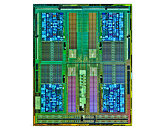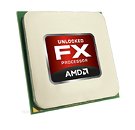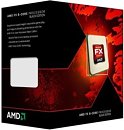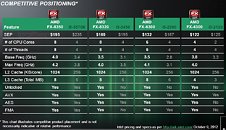Monday, October 22nd 2012

AMD Announces 2012 FX "Vishera" Line of Performance Desktop Processors
AMD announced the 2012 FX "Vishera" line of eight-core, six-core, and quad-core desktop processors. Based on the new "Piledriver" CPU micro-architecture, the new processors feature increased performance and an updated instruction set, over the previous generation. To begin with, the processors are based around the "Vishera" silicon, built on the 32 nm HKMG process at Global Foundries. With a transistor count of 1.2 billion and a die area of 315 mm², Vishera packs four Piledriver modules, with two cores each, 2 MB L2 cache per module (8 MB total), and 8 MB of L3 cache. Eight-, six-, and four-core models are carved out by toggling the number of modules between four, three, and two.
The Vishera silicon also features an updated CPU instruction set, which includes SSE/2/3/S3/4.1/4.2/4A, AVX, AES-NI, FMA/FMA2/FMA3, XOP, and F16C. An x86 processor by design, Vishera features the AMD64 x86-64 instruction set. Its updated integrated memory controller supports up to 64 GB of dual-channel DDR3 memory, with a standard speed of DDR3-1866 MHz, and more possible with overclocking. The memory interface is single, monolithic 128-bit, unlike the dual 64-bit IMC approach of the "Stars" micro-architecture. Built in the same socket AM3+ package as the previous generation FX, the new chips are compatible with existing AM3+ motherboards with a BIOS update. The 2012 FX processor lineup includes a total of four models, the FX-8350 flagship eight-core, FX-8320 performance eight-core, FX-6300 mainstream six-core, and FX-4300 value quad-core. All models feature unlocked base-clock multipliers, making each of them fit for overclocking. Their specifications and target SEP pricing are tabled below. Market prices could be about 5~10% above the SEP prices.
The Vishera silicon also features an updated CPU instruction set, which includes SSE/2/3/S3/4.1/4.2/4A, AVX, AES-NI, FMA/FMA2/FMA3, XOP, and F16C. An x86 processor by design, Vishera features the AMD64 x86-64 instruction set. Its updated integrated memory controller supports up to 64 GB of dual-channel DDR3 memory, with a standard speed of DDR3-1866 MHz, and more possible with overclocking. The memory interface is single, monolithic 128-bit, unlike the dual 64-bit IMC approach of the "Stars" micro-architecture. Built in the same socket AM3+ package as the previous generation FX, the new chips are compatible with existing AM3+ motherboards with a BIOS update. The 2012 FX processor lineup includes a total of four models, the FX-8350 flagship eight-core, FX-8320 performance eight-core, FX-6300 mainstream six-core, and FX-4300 value quad-core. All models feature unlocked base-clock multipliers, making each of them fit for overclocking. Their specifications and target SEP pricing are tabled below. Market prices could be about 5~10% above the SEP prices.




40 Comments on AMD Announces 2012 FX "Vishera" Line of Performance Desktop Processors
Computer Hardware, AMD, Processors - Desktops, So...
5%-10% all right.
EDIT: NVM, newegg has it.
omg, i'm very excited, and also this new amd's processor line up make me lil bit confused about to build a new pc based on trinity series or vishera series..:respect:
Bit more in-depth review here, and TBH it does pretty good, up to the 2600K more so and thats what i was after.
Piledriver is a fail in my book.
AMD FX-8350 and FX-6300 Piledriver Review
"The bottom line is that the Piledriver FX series provides a quick, affordable upgrade for folks still using lower-end K10 hardware, but there isn't a lot to see for those running high-end Phenom II X4 and X6 processors, regardless of how cheap the new parts may be. For those building a fresh rig from scratch, Ivy Bridge will likely still be more attractive thanks to its superior single thread performance and efficiency."
Well if the price is right and someone wants a gaming rig on a budget, sounds like AMD is the way to go.
The improvements made look like they were on target.
The power consumption is improved; don't forget Intel and AMD are using different manufacturing processes for their silicon, and Intel is ahead by at least one process node, probably two nodes. The different processes lead to differences in voltage between Intel and AMD chips, and differences in power consumption.
If you're a high-usage gamer, go with an Intel rig.
If you're in need of a professional workstation, look elsewhere.
If you do a little bit of everything, don't do a lot of gaming, and have a motherboard that can take this cpu, go for it.
I think this will be a nice low cost upgrade for me; I actually have a use for the extra cores.
Actually, I almost did not do a launch review, since AMD provided nothing but the bare chip for review. When I first got the chip, working BIOses weren't really available yet either.
So..uh, i think the watercooler might be a package, but we heard that with Bulldozer, and then they took forever to go on sale. I bought mine own from another reviewer, since I didn't do a Bulldozer review for TPU.
Why is that AMD always gets all the beating on their first release of an architecture and later gets it fixed? Do they have proper QA team?
BTW where is trickson?
However, I buy Intel for myself because Microcenter always has combo deal (cpu+main) which is cheaper than newegg or any other online retailer at least 35%, otherwise, I would buy AMD.
Also, people should realize that we've came to a point where cpu's performance is no longer matter for gaming due to better programming for multicore cpu.
What is really matter now is gpu. Spend less on cpu and get a better gpu will give you more FPS!